On November 1…
“Something I will never forget was the heat. Not the blast, but the heat. It just kept coming on and on. The heat doesn’t go off.
“Every five years all world leaders should witness a multi-megaton shot such as Ivy Mike. It would really put the fear of Allah, or God, or Mohammed, or Buddha, or somebody, in their veins.”
~Harold Agnew
Observed the Detonation of “Ivy Mike”
From 25 Miles Away
============================
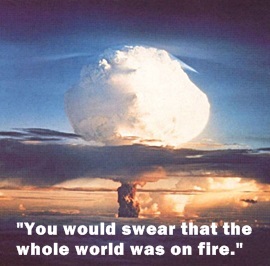
============================

1512 – Michelangelo’s paintings on the ceiling of the Sistine Chapel were first exhibited to the public on All Saints Day.
Michelangelo had been commissioned by Pope Julius II in 1508 to repaint the vault, or ceiling, of the Chapel.
The painted area – comprised of 343 figures – is about 131 feet long and 43 feet wide. Michelangelo painted well over 5,000 square feet of frescoes during the four-year project.
He Came Back Factoid: Michelangelo would return to the Sistine Chapel twenty-five years later and begin another four-year commission … The Last Judgment, which covers the whole altar wall of the Chapel.
It is a depiction of the Second Coming of Christ and the final and eternal judgment by God of all humanity.
Michelangelo was nearly 67 at its completion.
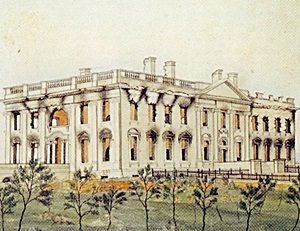
1800 – John Adams became the first President of the United States to live in the Executive Mansion (later renamed the White House).
Previously, George Washington and Adams had occupied a three-and-a-half-story brick mansion on the south side of Market Street in Philadelphia, the temporary capital of the U.S.
On his second evening in its damp, unfinished rooms, Adams wrote to his wife Abigail.
“Before I end my letter, I pray Heaven to bestow the best of Blessings on this House and all that shall hereafter inhabit it. May none but honest and wise Men ever rule under this roof.”
Adams didn’t stay long. He was defeated by Thomas Jefferson in the Election of 1800.

1911 – The world’s first combat aerial bombing mission took place in Libya.
Lieutenant Giulio Gavotti, an Italian pilot flying an Etrich Taube monoplane, dropped four hand grenades on Turkish troops camped at Ain Zara in Libya during the Italo-Turkish War.
Flying at an altitude of 600 feet, Gavotti (shown above) took the grenades – each one the size of a grapefruit and weighing about four pounds – from a leather pouch, screwed in the detonators, and tossed each missile over the side.
Though Lt. Gavotti’s raid produced no casualties and was initially regarded by other nations as “ungentlemanly,” the use of air power as an instrument of war became one of the 20th century’s more rueful contributions.
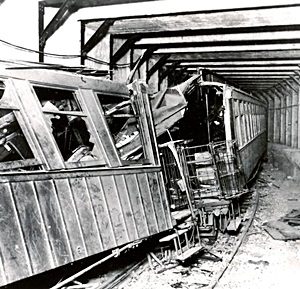
1918 – The worst rapid transit accident in U.S. history killed 102.
The crash occurred under the intersection of Malbone Street and Flatbush Avenue in Brooklyn.
An elevated train, consisting of five cars constructed primarily of wood, entered the tunnel portal beneath Malbone Street and attempted to negotiate a curve designated to be taken at 6 miles per hour.
The problem was the fact the train was traveling at an estimated speed of 30 mph.
The back wheels of the first car derailed, causing the second and third cars of the train to crash against the tunnel wall.
Passengers were imprisoned “in a darkened jungle of steel dust and wood splinters, glass shards and iron beams projecting like bayonets.”
The motorman for the accident was 25-year-old Antonio Edward Luciano, a crew dispatcher who had never operated an elevated train in passenger service before.
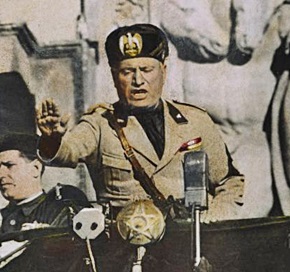
1936 – In a speech in Milan, Italy, Benito Mussolini described the alliance between his country and Nazi Germany as an “axis” running between Rome and Berlin.
“This Berlin-Rome protocol is not a barrier, it is rather an axis around which all European States animated by a desire for peace may collaborate on troubles.”
He may have been claiming the entire world would revolve around “the axis,” but in reality, the partnership with Germany was more one of convenience than necessity.
Hitler and Mussolini found themselves in a similar political situation, both ostracized from the League of Nations by the time they formed their alliance.
Mussolini was eager to ally himself with whoever seemed to be the strongest in Europe, and Hitler for his part used Italy’s military adventures in Africa to distract the rest of Europe from his own remilitarization.
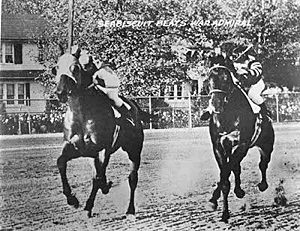
1938 – Seabiscuit defeated War Admiral in an upset victory during a match race deemed “the match of the century” in horse racing.
The event was run over 1 3⁄16 miles at Pimlico Race Course. Trains were run from all over the country to bring fans to the race, and the estimated 40,000 at the track were joined by 40 million listening on the radio to famed announcer Clem McCarthy.

1941 – Photographer Ansel Adams took a picture that would become one of the most famous images in the history of photography.
The photograph shows the Moon rising over the town of Hernandez, New Mexico; a black sky above a collection of modest dwellings, a church and a cross-filled graveyard, with snow-covered mountains in the background.
Adams captured a single image, with the dying second of sunset lighting the white crosses and buildings.
Art historian H. W. Janson called the photograph “a perfect marriage of straight and pure photography”
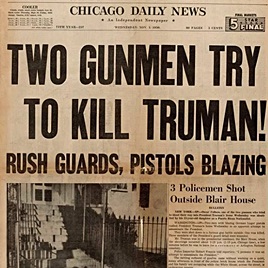
1950 – Two Puerto Rican nationalists tried to force their way into Blair House in Washington to assassinate President Harry S. Truman.
From 1948 to 1952, Truman and his family lived in Blair House, on the north side of Pennsylvania Avenue near the White House, while the executive mansion underwent extensive renovations.
Truman was taking a nap in the front bedroom. In the assassination attempt, two Puerto Rican nationalists – Oscar Collazo and Griselio Torresola – attempted to shoot their way into Blair House, assassinate the president and kick off a revolution in the United States.
Torresola and Collazo belonged to the extremist Puerto Rican Nationalist Party, which sought to gain independence from the United States. The “Independistas” had targeted Truman even though the president backed Puerto Rican autonomy.
Secret Service uniformed officer Leslie Coffelt was stationed in the guard house, positioned one building to the west of Blair House. Torresola walked up to the guard house, took aim and unloaded four bullets into the officer.
With a gun battle blazing on Pennsylvania Avenue, Torresola headed east, just steps away from Blair House to reload his pistol.
At that moment, President Truman, startled by the sounds of gunfire, looked out the window, directly in the line of sight of the would-be assassin. A nearby officer frantically waved and shouted for the president to get back.
As if on cue, Leslie Coffelt, bleeding to death but determined to protect the president, emerged from the guard booth, staggered to the side and leaned up against it as he took aim for Torresola.
He fired one bullet, hitting him just above the ear, killing him instantly. Coffelt limped back to the booth and blacked out. He died of his wounds four hours later in a hospital.
Floyd Boring, a Secret Service special agent, and uniformed officer Joseph Davidson, opened fire on Collazo with their service revolvers. Collazo returned fire but found himself outgunned.
Soon after, Collazo was struck by two .38-caliber rounds in the chest and right arm.
Collazo was sentenced to death, but on July 24, 1952, Truman commuted the sentence to life imprisonment. President Jimmy Carter commuted Collazo’s life sentence in September 1979, and he was freed from prison. He died in Puerto Rico on Feb. 20, 1994, at the age of 80.
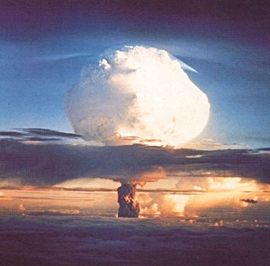
1952 – The United States exploded the first true hydrogen bomb.
“Ivy Mike” weighed 82 tons and the explosion created by its detonation destroyed the island of Elugelab, part of the Enewetak Atoll in the Marshall Islands.
The blast yielded 10.4 megatons of explosive energy, 700 times the energy that leveled central Hiroshima.
The island “became dust and ash, pulled upward to form a mushroom cloud that rose about twenty-seven miles into the sky.”
All that remained of Elugelab was a circular crater filled with seawater, almost 2 miles in diameter and 154 feet deep.
High levels of radiation blanketed much of the atoll following the test.

1955 – Dale Carnegie died of Hodgkin’s disease at the age of 66.
Carnegie became an international celebrity with his hugely popular How To Win Friends and Influence People.
Like most of his books, it revealed little that was unknown about human psychology but stressed that an individual’s attitude is crucial. He taught that anyone could benefit from a handicap if it were advantageously presented.
The book was a bestseller from its debut in 1936, in its 17th printing within a few months.
By the time of Carnegie’s death, the book had sold five million copies in 31 languages, and there had been 450,000 graduates of his Dale Carnegie Institute.
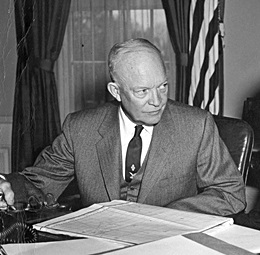
1955 – The Vietnam War began.
That was the day when the Military Assistance Advisory Group (MAAG) Vietnam was created by President Dwight Eisenhower.
It superseded MAAG Indochina, which had been established in 1950 under President Harry Truman, to support South Vietnam in their war against the North Vietnamese communists.
MAAG Vietnam took over from the French the task of training and organizing the Vietnamese National Army.
And we all know how that turned out.
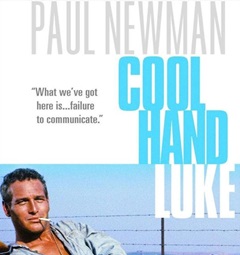
1967 – Cool Hand Luke premiered at Loew’s State Theatre in New York City.
The film, starring Paul Newman, George Kennedy, and Strother Martin, was a huge box office success and earned four Academy Award nominations (Kennedy won Best Supporting Actor).
Newman was nominated for Best Actor but lost out to Rod Steiger (for In The Heat Of The Night).
Not only was Newman up against Steiger’s extraordinary performance, he was also in competition with Dustin Hoffman (The Graduate), Spencer Tracy (Guess Who’s Coming To Dinner, and Warren Beatty (Bonnie and Clyde).
Idle Thought: 1967 was one hell of an amazing year for movies!
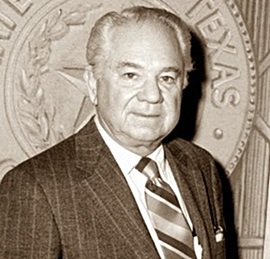
1973 – Under extreme criticism for the firing of Archibald Cox, Nixon appointed Leon Jaworski to replace him as the new Watergate Special Prosecutor.
Jaworski subsequently subpoenaed sixty-four taped conversations. Nixon appealed on two grounds: first, that the office of Special Prosecutor did not have the right to sue the office of President; and second, that the requested materials were privileged presidential conversations.
Aware that an important constitutional issue was at stake, Jaworski asked the Supreme Court to take the case directly, bypassing the Court of Appeals.
On July 24, 1974, the Supreme Court ruled that the Special Prosecutor did have the right to sue the President; and that the “generalized assertion of [executive] privilege must yield to the demonstrated, specific need for evidence in a pending criminal trial”.
Nixon was forced to give the unedited tapes to Jaworski, including the so-called Smoking Gun Tape which included a compromising discussion of June 23, 1972.
The President’s remaining support waned, and he resigned on August 9, 1974.
In October 1974 Jaworski resigned as the Watergate Special Prosecutor and returned to his native Texas.

1985 – Actor/comedian Phil Silvers died of natural causes at the age of 74.
He is best remembered for his role as Sgt. Bilko in the 1950s television series The Phil Silvers Show, but he also appeared in over 60 films, including It’s a Mad, Mad, Mad, Mad World and A Funny Thing Happened on the Way to the Forum.
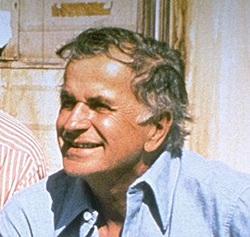
1994 – Actor Noah Beery, Jr. died of a cerebral thrombosis at the age of 81.
He was best known for playing James Garner’s father, Joseph “Rocky” Rockford, in the television series The Rockford Files, but he also had a rich film career.
He appeared in nearly 100 films during his 65-year career, including Sergeant York, Of Mice and Men, Red River, Only Angels Have Wings, Walking Tall, and Walking Tall, Part II.
Circus Boy Factoid: In the 1950s, Beery played Joey the Clown in Circus Boy for two seasons. His character adopted a young orphan (played by future Monkee Micky Dolenz – billed at the time as Micky Braddock).

1999 – NFL Hall of Fame running back Walter Payton died from a rare liver disease at the age of 45.
Nicknamed “Sweetness,” Payton was a star running back for the Chicago Bears, establishing multiple records and earning nine Pro Bowl selections during his Hall of Fame career.
Note: Due to a dwindling amount of interest on the part of readers, I am CONSIDERING announcing the end of the Daily Lesson.
I enjoy compiling them but it takes a lot of time and quite honestly, the number of readers has dropped very dramatically during the past few months.
It won’t happen immediately, if it happens at all, but I will be monitoring the numbers closely over the next few weeks.
Compiled by Ray Lemire ©2019 RayLemire.com / Streamingoldies.com. All Rights Reserved.